Active Bait Fishing
Active Bait Fishing involves striking at the first hint of a bite. That reduces post-release mortality almost to the same level as fly fishing, so catch and release bait fishing is reasonable.
This article is specifically about bait fishing for trout in streams.
Many of us were taught as kids fishing with worms to "wait until he's got it" before striking. That almost guarantees a deeply hooked fish, which is why the scientific studies nearly all show that bait fishing results in substantially more post-release mortality than fly fishing or spin fishing.
However, the few studies that looked at "active bait fishing" compared to "passive bait fishing" concluded that an active approach - striking at the first hint of a bite - just as fly fishermen do, reduces post-release mortality almost to the level of fly fishing. When using an active bait fishing approach, scientific studies show that bait fishing is not incompatible with catch and release. (Dubois, R. B.; Kuklinski, K. E. (2004). "Effect of Hook Type on Mortality, Trauma, and Capture Efficiency of Wild, Stream-Resident Trout Caught by Active Baitfishing". North American Journal of Fisheries Management. 24 (2): 617.)
Two things are very important when adopting an active bait fishing approach: choice of bait and the specific fishing method used.
Active Bait Fishing - Preferred Bait
I recommend red wigglers for three reasons. First, they catch fish. Second, you can raise them yourself,
easily and inexpensively
. However, from the standpoint of active bait fishing, perhaps the third reason is the most important: they are the right size! The whole point of active bait fishing is striking at the first hint of a bite. If the bait is too big, though, striking at the first hint of a bite doesn't always mean hooking the fish!
Lots of people fish with nightcrawlers. I think they are too large. Very few trout are large enough to take the whole nightcrawler in one bite. Thus, when you feel the tap, tap of a trout, you don't know whether he has the hook in his mouth or the part of the worm that doesn't have the hook. I know that many people will break a nightcrawler in half - but unless you use a hook that is overkill for the average trout, that is still too big a bait to be sure the trout has the hook.
Lots of people fish with the "Big Red Worms" or "Trout Worms" that are available in most bait shops or big box stores. They're a better size than nightcrawlers, but I think they are still too big for most trout to take in one bite. To be sure the trout has the hook you will have to either break the worm in half, which does make it about the right size, or fish with a multi-hook rig like the Stewart tackle introduced by WC Stewart in The Practical Angler.
 Stewart Tackle with four small hooks.
Stewart Tackle with four small hooks.Many states limit the number of hooks you can use, so a four-hook Stewart tackle may not be legal where you fish. You could use a three-hook Stewart tackle, or a two-hook version (called Pennell Tackle), but a Big Red Worm with two hooks still leaves a lot of worm that doesn't have a hook in it.
I assume you know that bunching the worm into a ball by hooking it over and over and over is much less effective because it no longer looks like a natural worm tumbling down the stream. Actually, I shouldn't assume that because that is exacty how most people hook worms!
A red wiggler is small enough to hook just once and still have a very good chance that when the fish takes the worm it also gets the hook
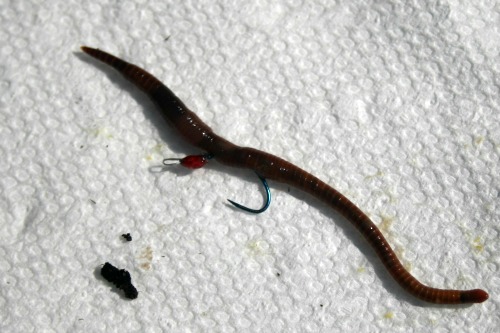 Threaded
Threaded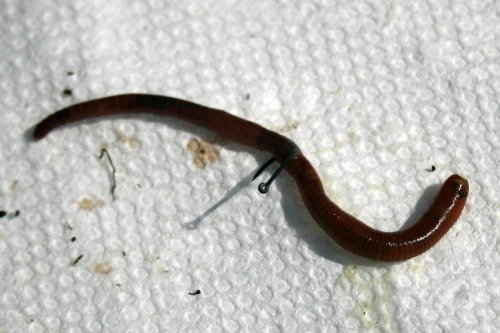 Crossways
CrosswaysIf you use either hooking method shown above, both ends of the red wiggler are free to wiggle naturally. Although it looks like a trout could easily grab just one end of the worm, the worms are only about 1.5" long, so the trout almost always gets the hook in its mouth, too. I have found that if you do strike and miss the fish completely, so it did not feel the hook, it will often bite again on the next cast.
I think it is also possible for the bait to be too small. I do not recommend salmon eggs if you intend to release your catch. They are so small that trout do not have to chew them or move them around to get them in position to swallow them. Trout swallow the eggs almost instantly. Thus, there is a much higher likelihood of deep hooking with salmon eggs than with red wigglers.
Fish by Sight, Not by Feel
The most effective active bait fishing is with a long rod - a very long rod. That will allow you to keep nearly all of the line off the water's surface. If the line is in the air, not in the water, it is very easy to see a subtle twitch or hesitation in the line, which you need to see if you are going to consistently hook fish in the mouth.
I would highly recommend either the Keiryu fishing style or the Upstream Worm fishing style. Both styles allow you to see strikes that you would not feel until it is too late. Both styles also allow you to know the fish is there before it knows you're there. If you feel the fish, you can be sure that it also feels you, and very often it is quicker than you are! Trout really will spit out live bait if they feel tension on the line.
Whether to use the Keiryu style or the Upstream Worm style depends mostly on water
depth.
For shallow water, up to perhaps knee deep, a size 3 tenkara line
will provide sufficient weight to cast (for most tenkara, keiryu or seiryu rods). No added weight
is needed if the water is up to about 14 inches deep. Cast upstream and gradually raise your rod tip so the worm drifts downstream at the same speed as the current. With no added weight, the worm tumbles down the stream in a completely natural fashion. It goes with the flow - around or over rocks rather than into them, rarely getting snagged. Thus, if the line hesitates or even twitches it is probably a fish.
For slightly deeper water, up to about knee deep, one or two #10 shot, or perhaps one #6
shot should be sufficient. Don't add enough to take it to the bottom or you will get lots of snags and you will start delaying your strike to make sure it is a fish instead of a rock. The whole point of active bait fishing is to set the hook instantly. The first time you think you have a fish but it turns out to be a rock is not a sign to wait next time to see if it really is a fish, it is a sign to use less weight. You want to know, in almost every case, that any time the worm stops it is because a fish has taken it.
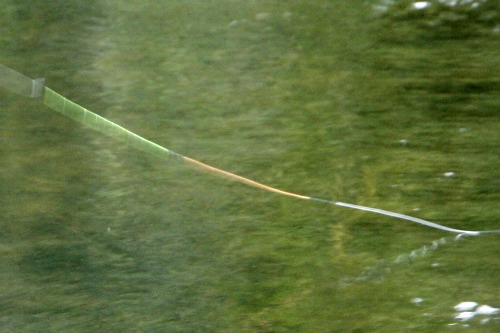 Line sag provides some slack.
Line sag provides some slack.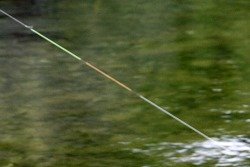 Sag disappears when fish takes.
Sag disappears when fish takes.The tenkara line will have some sag, and the slack caused
by the sag allows the fish to take the worm without feeling tension on
the line. When a fish takes, you will see the line tighten or move to the side. Immediately
tighten the line to set the hook.
Don't jerk, just tighten the line. This is the method I wrote about in Ultralight Worm Fishing and in Upstream Worm Hooks. The photos show the TenkaraBum Tactical Nymphing Sighter (since discontinued) but size 3 tenkara line will work as well.
For water over knee deep, you will probably need more weight,
possibly one BB shot For that depth, but sespecially for that weight, weight, it is better to use
a keiryu rig. My Keiryu Lines article explains how to make a keiryu rig.
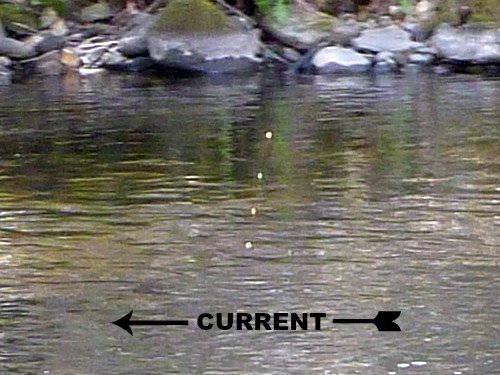 When keiryu fishing, hold the rod so that the bottom marker knot is downstream of the top knot.
When keiryu fishing, hold the rod so that the bottom marker knot is downstream of the top knot.Tie three to four yarn markers around the main portion of the line so that the lowest one is above the surface when the split shot is just occasionally ticking the bottom. Watch the markers for indication of a strike or a snag.
For this rig, fishing across is better than fishing upstream. Follow the markers with your rod tip, keeping the line angled as shown in the photo above.
Initially, you will not be able to tell if a dip in the markers is
caused by a fish or by a rock. If you then set the hook by pulling
the rod upstream, it will still hook a fish but will often dislodge the
hook or split shot from a rock, whereas setting the hook by pulling
the rod tip downstream can make a snag impossible to free. You can't
pull the line upstream to strike if the hook is upstream from where you
are standing. (Fishing upstream is fine when using no weight in shallow
water because the unweighted worm almost never gets snagged on rocks.)
With
practice, you may be able to differentiate the sharper dip or twitch in
the markers caused by a fish taking the bait from the slower change in
the orientation of the markers caused by the hook or split shot hanging
up on a rock or twig. For a snag, the markers will often change from
angling upstream as shown in the photo above, to forming a slight "C"
shape, to then angling downstream.
You will not have to strike sharply to set the hook. Just move the rod tip to tighten the line. It should be quick but not forceful.
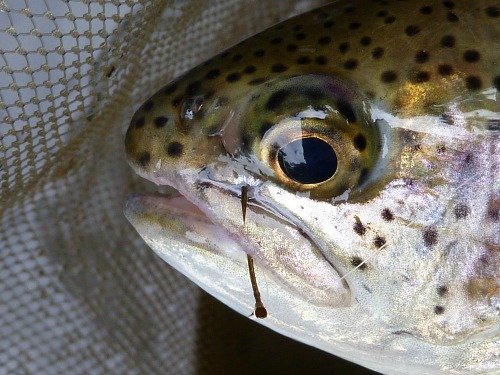 Same hook location as when fly fishing.
Same hook location as when fly fishing.For both rigs, but for the tenkara line rig in particular, you will
see strikes long before you feel them, and before the fish have a chance
to swallow the worm. With the keiryu rig, which is more vertical,
you will often feel the hit at the same time you see it - but not always
- if the fish takes the worm and goes to the side rather than down, you
may not feel a thing until it is much too late.
The reason keiryu rods have soft tips is to allow the ling, and thus the markers, to dip before there is much tension on the line. Ideally, you see the
strike before the fish feels the tension. If you are waiting to feel the
strike, you are giving up that advantage. When you feel the fish, it
feels you! Either the fish will spit out the worm, which it really will
do if the line is tight and it feels the tension on the line, or it
will have had time to swallow the bait if the line had been slack.
A little slack in the line is not a bad thing - if you can see the line and see it start to straighten, or move to the side, or just twitch. Basically, any movement in the line that you didn't cause and that little wavelets on the water's surface didn't cause is a reason to tighten the line. You don't need to strike hard but you do need to react quickly. Don't wait to see if it is a rock or a fish. You'll know as soon as you tighten the line. Fish wiggle, rocks don't.
When fishing with the Ultralight Worm Fishing method using a tenkara line and no weight, the worm will rarely get caught on rocks, so any tightening of the line is probably a fish. With the Keiryu method using yarn markers and split shot, if your markers are downstream of your rod tip, as shown in the photo above, striking by pulling the rod tip upstream will usually hook a fish but will often pull the hook or split shot off a rock.
There is no reason at all to delay the hook set. The whole key to active bait fishing is striking at the first hint of a bite. The advantage of either a keiryu fishing approach or an Ultralight Worm Fishing approach is that you see the first hint if a bite long before you could feel it, and before the fish knows you're there. That no only hooks the fish, it hooks it in the mouth where you can safely remove the hook and release the fish.
TenkaraBum Home > Worm Fishing > Active Bait Fishing
“The bitterness of poor quality remains long after the sweetness of low price is forgotten” - Benjamin Franklin
"Be sure in casting, that your fly fall first into the water, for if the line fall first, it scares or frightens the fish..." -
Col. Robert Venables 1662
As age slows my pace, I will become more like the heron.
We've all had situations where seriously chewed up flies kept catching fish after fish after fish. It is no sin to tie flies that come off the vise looking seriously chewed up.
Warning:
The hooks are sharp.
The coffee's hot.
The fish are slippery when wet.
Beware of the Dogma
Seriously, all the hooks sold on TenkaraBum.com, whether packaged as loose hooks or incorporated into flies, are dangerously sharp. Some have barbs, which make removal from skin, eyes or clothing difficult. Wear eye protection. Wear a broad-brimmed hat. If you fish with or around children, bend down all hook barbs and make sure the children wear eye protection and broad-brimmed hats. Be aware of your back cast so no one gets hooked.
Also, all the rods sold on TenkaraBum.com will conduct electricity. Do not, under any circumstances, fish during a thunder storm. Consider any fishing rod to be a lightning rod! Fishing rods can and do get hit by lightning!
What's in stock?
Suntech Tenkarakyo 40F Tenkara Rods
Daiwa Keiryu-X 39
Nissin Oni Tenkara Line
Coming Soon
January
Kurenai II AR 30F
Kurenai II AR 33F
Kurenai II AR 39F
Nissin Oni Line size 3
Nissin Oni Line size 3.5
TenkaraBum 33
TenkaraBum 36
TenkaraBum 40
Medium Rod Case
Furaibo TF39
Furaibo TF39TA
Latest Pages
Related Items
Size 2.5 tenkara line (hi-vis)
Tactical Nymphing Sighter
If you enjoy spin fishing or baitcasting please visit my sister site Finesse-Fishing.com.


